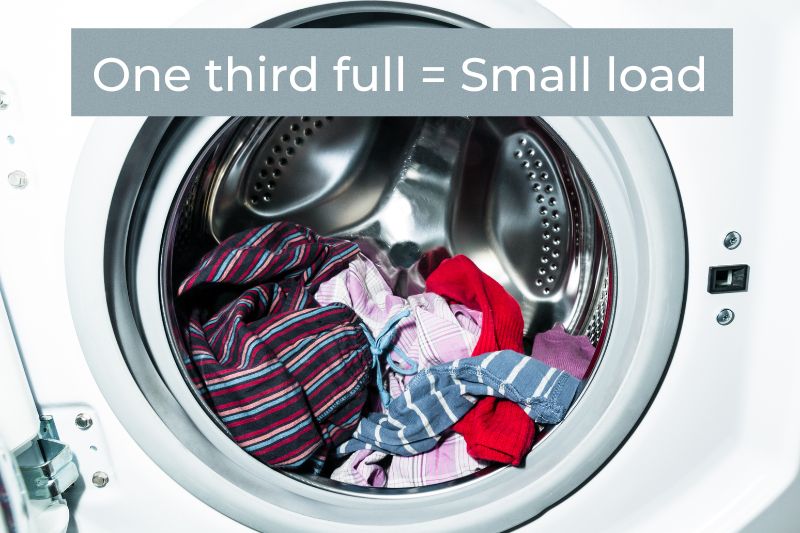If you’ve picked up a laundry cleaner that tells you how much product to use based on the size of your washing pile (small, medium or large), you might be a tad confused.
It’s not the easiest thing in the world trying to decipher what counts as a small, medium or large load of washing! But luckily for you, you’ve come to the right place.
Let’s take a closer look at what a small load of laundry really is.
What Is a ‘Small’ Load of Laundry?
A small load of laundry is when your washing machine’s drum is filled up a third of the way with dirty washing. The rest of the drum (two thirds) is left empty, so the laundry can move around.
Of course, how much laundry it takes to fill a third of your washing machine depends on its capacity. So, you’ll have to adjust the figures below to suit your washing machine.
For example, if you have a 9 kg appliance, a third would be the equivalent of about 3 kg of dry laundry. If you have a 6 kg machine, a third would be about 2 kg of laundry.
If you were to put these piles of laundry next to each other, you’d see a noticeable difference in their size. But this is absolutely fine because it’s all relative to the size of your drum.
Naturally, a small load in a big washing machine will look much bigger than a small load in a small machine.
The only way to work out how many items you can pop into your washing machine to make up a ‘small load’ is to weigh your laundry, or estimate the weight. You can learn more about calculating the weight of your laundry below.
In addition to the above, it’s worth finding out what the ‘minimum amount of weight’ you can put into your drum is.
Most washing machine handbooks will tell you that you need to add a certain amount to your drum, so it actually works properly. (This is usually around three pounds, or 1.4 kg).
So, bear this in mind if you’re only going to be washing a few items here and there. Not adding enough laundry could do more harm than good to your appliance!

Is It Wasteful to Do a Small Load of Laundry?
Yes, if you run small loads all the time you are going to be using more energy, money, and laundry products than necessary.
Over a period of time, you might find it rather costly to complete such cycles. So, if you could combine a few of the loads together to make a medium sized load, it would be beneficial and would save you money and time.
Plus, underloading a washing machine will encourage excessive vibrations. This, in turn, might put the machine off balance slightly, and could lead to complications in the future, particularly with regards to moving parts inside the appliance. And there may be a lot of noise to put up with as the laundry clunks around in a mostly empty drum.
In addition to this, one consequence of doing small loads of laundry is that you might have to do a small drying cycle too. So, unless you line dry your washing, you’ll have to factor in how much it’ll cost to run these drying cycles.
That being said, if you don’t have any other option and you’ve got to do small loads, you can do so. Just be prepared to absorb the additional costs.
If you’re going to do small loads of laundry frequently, check to see if there is a ‘medium load’ or ‘half load’ setting on your appliance. If you have got this feature, you should use it because it’s purpose is to run more economical washes for smaller loads of laundry. So, it could save you water, and hopefully money in the long run.
What’s Considered a Medium, Large, and Overloaded Load of Laundry?
As a point of reference, a medium-sized load is when the drum is about half full. This is often considered to be a normal load because it isn’t too small and it isn’t too big. Plus, laundry has plenty of room to spin in the drum.
A large load is when the drum is three-quarters full, and there’s typically enough room in the drum for clothes to spin around.
Generally, a washing machine shouldn’t be run when it’s at 100% capacity because it won’t be able to wash clothes effectively, which is why you only fill it three-quarters of the way.save
An overloaded load is when the washing machine is completely full, and there’s no room for the laundry to move around. Washing won’t be washed properly, and you’ll likely have to re-wash clothes after such a full cycle.

Calculating Laundry Weight
When doing a load of laundry, it’s important that you have a rough idea about how much your laundry weighs.
If you overfill your washing machine, the machine might not wash your clothes properly. This, in turn, can put a lot of strain on the mechanisms that spin the drum and can wear them out quicker.
On the flipside, if you underfill your appliance, you’ll likely hear a thudding noise as the items spin around in the drum. Plus, you’ll likely waste a lot of detergent (because you might not adjust the dose), money and time.
Of course, weighing every single item of clothing seems like a daunting, and, let’s face it, a boring job! So, how do you find out how much your laundry weighs, so you add the right amount of clothes to the machine?
All you need to do is stand on a scale and weigh yourself. Once you’ve done this you can stand on the scale again, only this time you’ll need to hold your pile of washing. When you’re done, you’ll need to note down the figure that pops up!
You should now have two figures; your weight and your weight when holding the washing. All you need to do now is subtract the smaller number (your weight) from the larger number (your weight plus laundry), and you’ll find out how much your washing pile weighs.
For more information and tips, read our laundry weight guide.

Bethan has a passion for exploring, reading, cooking and gardening! When she’s not creating culinary delights for her family, she’s concocting potions to keep her house clean!






